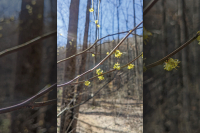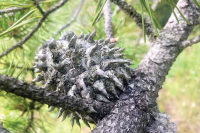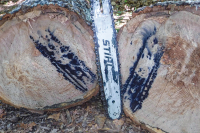The Joyful Botanist: Banking on it
 Allegheny Live-Forever (Hylotelephium telephioides)
Adam Bigelow photo
Allegheny Live-Forever (Hylotelephium telephioides)
Adam Bigelow photo
There are many places and things that you can bank on in our world. You can call bank on a basketball court or pool table. You can carve a bank on a skateboard. You can donate food to a food bank or blood to a blood bank. You can upload data to a data bank that runs on multiple levels of memory banks. You can climb down the riverbank to take a dip.
Of course, you can put your money into a checking or savings account, and you can add your coins to a piggy bank. While my piggy bank is named Ira, I’m certainly not banking on it having enough for my retirement.
When it comes to return on investment, however, almost nothing beats the soil seed bank. While you may not have seen this among the many investment houses and financial institutions, the soil seed bank is loaded and usually secure.
This kind of bank is found in topsoil all around the world and is a large part of the resilience of an ecosystem. Just under the ground, below the growing plants and fallen leaves and under the duff that connects the above and below ground parts of the soil lies the seed bank. When a disturbance happens, major or minor, like a single tree falling or a whole line of trees taken out by tornado or hurricane, it is from the seed bank that recovery begins.
Seeds can lie dormant just under the ground for many years. There are short-lived seeds referred to as transient seeds, that will only be able to germinate for a couple of years. And then there are seeds of plants that can live dormant in the soil for many decades or in the right conditions, for hundreds of years. This is great when it comes to disturbance recovery, as often what grows after a storm are native plants well adapted to the environmental conditions of an area.
Problematic non-native seeds, those we call invasive that cause harm in the ecosystem by outcompeting and replacing native plants, are often found in the soil seed bank. The bittersweet weed (Celastrus orbiculatus) might be one of the most prolific and long-lived seeds in the soil. And that is a problem because they produce a whole lot of seeds every year. Even if you do the good work of removing bittersweet weed from your property, seeds of the invasive bittersweet can remain viable in the soil for upwards of 95 years.
Related Items
This means that one day long after your successful mitigation of this plant, a single seed of bittersweet weed can be exposed to the conditions it requires to germinate and begin to grow and reinfest a previously cleared area. Research shows that when you clear an area of herbaceous plants, what often comes in first are exotic and invasive plants. Luckily, after clearing invasive shrubs and trees, it is more likely that native plants will fill in where the invasive shrubs were removed.
The seed bank is responsible for many a gardener’s experience of pulling up weeds in your veggie garden, only to find more weeds germinating and growing right afterward. In organic gardening, trying to reduce soil disturbance by minimizing tilling and cutting weeds instead of pulling them can help keep the seed bank from flushing out too much.
And, as the Western North Carolina region begins the ecological restoration and recovery work that lies ahead, I am rooting for the soil seed bank to burst into regenerative action and help hold the soil and regrow the forests and meadows in all but the most deeply scoured areas. In fact, I’m banking on it.
(The Joyful Botanist leads weekly wildflower walks most Fridays and offers consultations and private group tours through Bigelow’s Botanical Excursions. This email address is being protected from spambots. You need JavaScript enabled to view it..)













